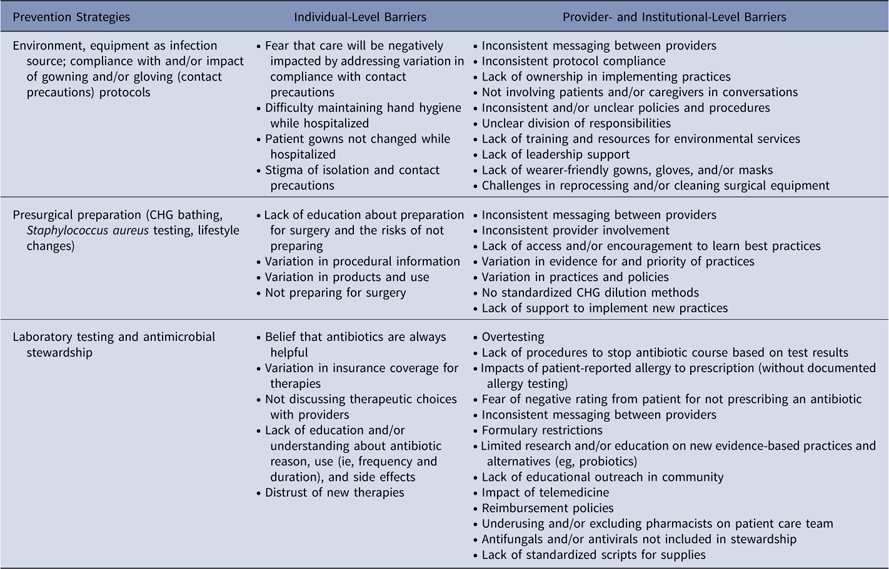To the Editor—Due to its many benefits, stakeholder engagement in health research has been increasingly prioritized in recent years.Reference Mackie, Sheldrick, De Ferranti, Saunders, Rojas and Leslie 1 – Reference Domecq, Prutsky and Elraiyah 9 Engagement throughout the research cycle, from idea development through dissemination of results, helps to ensure that research questions and outcomes are meaningful and relevant to stakeholders,Reference Forsythe, Heckert, Margolis, Schrandt and Frank 3 , Reference Jagosh, Macaulay and Pluye 4 and it may also improve research quality and appropriateness.Reference Jagosh, Macaulay and Pluye 4 – Reference Brett, Staniszewska and Mockford 6 , Reference Domecq, Prutsky and Elraiyah 9
Given the threat of healthcare-associated infections (HAIs) to patient safety,Reference Safdar, Anderson and Braun 10 stakeholder engagement is critical in healthcare epidemiology. Effective HAI prevention and control require collaboration between multiple stakeholders: clinicians, other providers directly or indirectly involved in patient care, healthcare administrators, caregivers, and patients. Despite progress in understanding pathogens, epidemiology, and prevention and control mechanisms, many research gaps remain.Reference Safdar, Anderson and Braun 10 Because patients and caregivers have not previously been involved as stakeholders in HAI research, their perspectives on these gaps are poorly understood. We believe that increasing the engagement of patients and caregivers in HAI research is necessary to address existing gaps in knowledge related to HAI prevention.
To develop a patient-centered HAI research agenda, we convened a patient and caregiver stakeholder (PCS) group of 7 older adults (4 men, 3 women, most >50 years old) from Wisconsin. All members had experience as a patient or as a caregiver to a patient with an HAI, and 2 members had additional professional medical experience. Before discussing the research agenda, the PCS group members received initial training in HAI research, terminology, and concepts, and they participated in preparatory activities such as describing their perceptions of environmental contamination in a hospital room and meeting with institutional stakeholders to discuss HAI work.
Research agenda discussions centered on a subset of strategies identified by the Society for Healthcare Epidemiology of America (SHEA)10: (1) evaluation of environment and equipment sources for infection; (2) compliance with and impact of contact precautions; (3) patient presurgical preparation; and (4) antibiotic stewardship, particularly the role of pharmacists. In consultation with the Wisconsin Network for Research Support (www.winrs.nursing.wisc.edu/), we designed an activity for stakeholders to identify their perceived individual (patient and/or caregiver) and provider- or institutional-level barriers to implementing a strategy. Their ideas were elaborated through discussions with the research team, and the resulting barriers represent potential targets for intervention in future patient-centered HAI research (Table 1).
Table 1 Patient-Perceived Implementation Barriers to HAI Prevention Strategies

Note. HAI, healthcare-associated infections; CHG, chlorhexidine gluconate.
Patient feedback provides important context to previously described HAI prevention research topics.Reference Safdar, Anderson and Braun 10 For example, patients highlighted concern that care may be negatively impacted by asking providers about noncompliance with contact precaution protocols. While HAI research is often focused within healthcare settings, patients wanted to know the steps they could take outside the healthcare setting to reduce their risk of acquiring HAIs. However, the demographics of the PCS group may limit the generalizability of these results to other patient populations.
These perspectives have been critical as we identify priority areas for investigation and as we engage patients in developing research projects to address these areas. We encourage other researchers to consult with patients and caregivers in setting their research agendas and to develop a patient-centered plan aligned with the needs of those who know the most about living with an HAI.
Acknowledgments
The views in this article are those of the authors and do not necessarily represent the position or policy of the Department of Veterans Affairs or the United States government. The Wisconsin Network for Research Support aided in editing the manuscript.
Financial support
This work was supported by the Department of Veterans Affairs Quality Enhancement Research Initiative program (grant no. PEC 15-248) in partnership with the VA National Center for Patient Safety, and it was partially funded through a Patient-Centered Outcomes Research Institute Eugene Washington Engagement Award (grant no. 2680-UWisc).
Conflicts of interest
All authors report no conflicts of interest relevant to this article.





